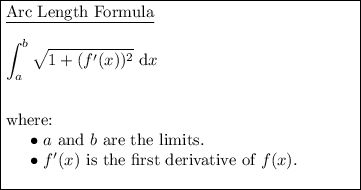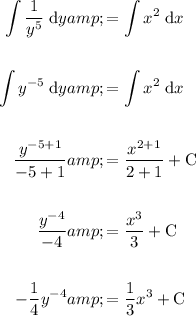Answer:


Explanation:
Question 5
To find the arc length of a given function between two points, we can use the Arc Length Formula:

The given function is:

Differentiate the given function:

As the function is in terms of x, the interval [a, b] is the x-values of the given points. Therefore:
Set up the integral using the arc length formula:

You will notice that this integral is not one of the given answer options.
We can also set up the integral with respect to y.
To do this, begin by rearranging the function so that x is a function of y:

Differentiate x with respect to y:

As the function is in terms of y, the interval [a, b] is the y-values of the given points. Therefore:
Set up the integral using the arc length formula:

Therefore, the correct answer option is option C.

Question 6
The given differential equation is:

Solving a differential equation means using it to find an equation in terms of the two variables, without a derivative term.
Rearrange the equation so that all the terms containing y are on the left-hand side, and all the terms containing x are on the right-hand side:

Integrate both sides:

Use the following integration rule:

Therefore:

Given y(0) = 1, substitute y = 1 and x = 0 into the equation and solve for C:

Therefore, the equation is:

Therefore, the correct answer option is option D.